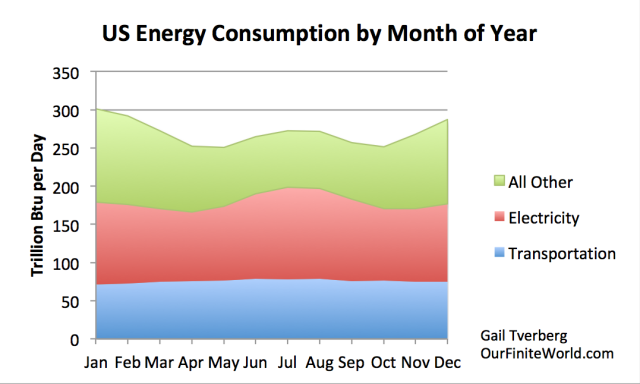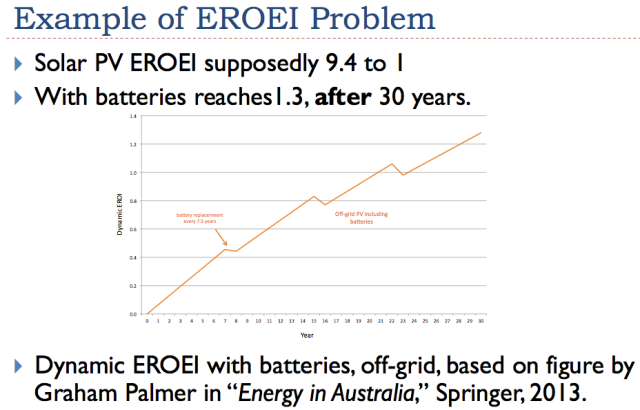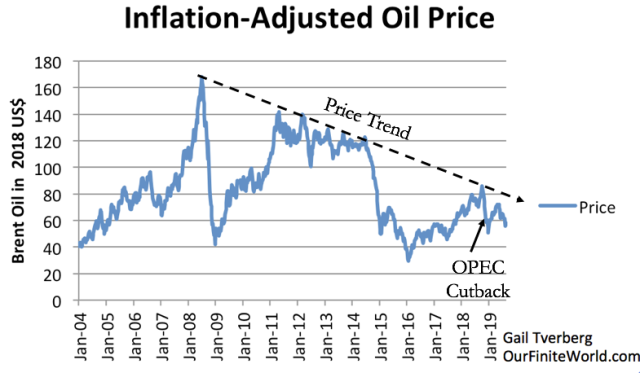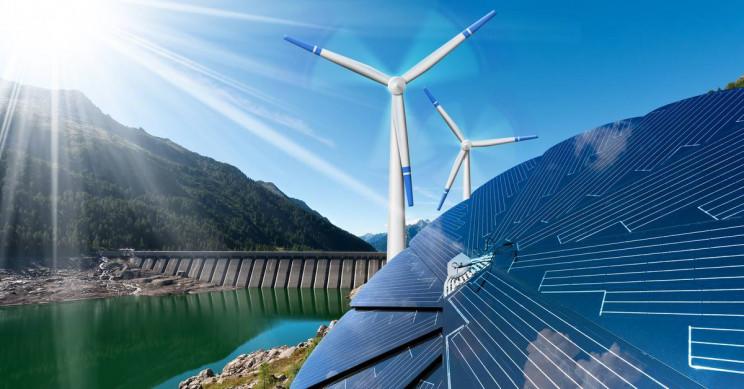Renewable Energy’s Inconvenient Truth
Authored by Gail Tverberg via Our Finite World blog,
The energy needs of the world’s economy seem to be easy to model. Energy consumption is measured in a variety of different ways including kilowatt hours, barrels of oil equivalent, British thermal units, kilocalories and joules. Two types of energy are equivalent if they produce the same number of units of energy, right?
For example, xkcd’s modeler Randall Munroe explains the benefit of renewable energy in the video below. He tells us that based on his model, solar, if scaled up to ridiculous levels, can provide enough renewable energy for ourselves and a half-dozen of our neighbors. Wind, if scaled up to absurd levels, can provide enough renewable energy for ourselves and a dozen of our neighbors.
There is a major catch to this analysis, however. The kinds of energy produced by wind and solar are not the kinds of energy that the economy needs. Wind and solar produce intermittent electricity available only at specific times and places. What the world economy needs is a variety of different energy types that match the energy requirements of the many devices in place in the world today. This energy needs to be transported to the right place and saved for the right time of day and the right time of year. There may even be a need to store this energy from year-to-year, because of possible droughts.
I think of the situation as being analogous to researchers deciding that it would be helpful or more efficient if humans could change their diets to 100% grass in the next 20 years. Grass is a form of energy product, but it is not the energy product that humans normally consume. It doesn’t seem to be toxic to humans in small quantities. It seems to grow quite well. Switching to the use of grass for food would seem to be beneficial from a CO2 perspective. The fact that humans have not evolved to eat grass is similar to the fact that the manufacturing and transport sectors of today’s economy have not developed around the use of intermittent electricity from wind and solar.
Substituting Grass for Food Might “Work,” but It Would Require Whole New Systems
If we consider other species, we find that animals with four stomachs can, in fact, live quite well on a diet of grass. These animals often have teeth that grow continuously because the silica in grass tends to wear down their teeth. If we could just get around these little details, we might be able to make the change. We would probably need to grow extra stomachs and add continuously growing teeth. Other adjustments might also be needed, such as a smaller brain. This would especially be the case if a grass-only diet is inadequate to support today’s brain growth and activity.
The problem with nearly all energy analyses today is that they use narrow boundaries. They look at only a small piece of the problem–generally the cost (or “energy cost”) of the devices themselves–and assume that this is the only cost involved in a change. In fact, researchers need to recognize that whole new systems may be required, analogous to the extra stomachs and ever-growing teeth. The issue is sometimes described as the need to have “wide boundaries” in analyses.
If the xkcd analysis netted out the indirect energy costs of the system, including energy related to all of the newly required systems, the results of the analysis would likely change considerably. The combined ability of wind and solar to power both one’s own home and those of a dozen and a half neighbors would likely disappear. Way too much of the output of the renewable system would be used to make the equivalent of extra stomachs and ever-growing teeth for the system to work. The world economy might not work as in the past, either, if the equivalent of the brain needs to be smaller.
Is “Energy Used by a Dozen of Our Neighbors” a Proper Metric?
Before I continue with my analysis of what goes wrong in modeling intermittent renewable energy, let me say a few words about the way Munroe quantifies the outcome of his energy analysis. He talks about “energy consumed by a household and a dozen of its neighbors.” We often hear news items about how many households can be served by a new electricity provider or how many households have been taken offline by a storm. The metric used by Munroe is similar. But, does it tell us what we need to know in this case?
Our economy requires energy consumption by many types of users, including governments to make roads and schools, farmers to plant crops and manufacturers to make devices of all kinds. Leaving non-residential energy consumption out of the calculation doesn’t make much sense. (Actually, we are not quite certain what Munroe has included in his calculation. His wording suggests that he included only residential energy consumption.) In the US, my analysis indicates that residential users consume only about a third of total energy.1 The rest is consumed by businesses and governments.
If we want to adjust Munroe’s indications to include energy consumed by businesses and governments, we need to divide the indicated number of residential households provided with energy by about three. Thus, instead of the units being “Energy Consumed by Dozen of our Neighbors,” the units would be “Energy Consumed by Four of Our Neighbors, including Associated Energy Use by Governments and Businesses.” The apparently huge benefit provided by wind and solar becomes much smaller when we divide by three, even before any other adjustments are made.
What Might the Indirect Costs of Wind and Solar Be?
There are a number of indirect costs:
(1) Transmission costs are much higher than those of other types of electricity, but they are not charged back to wind and solar in most studies.
A 2014 study by the International Energy Agency indicates that transmission costs for wind are approximately three times the cost of transmission costs for coal or nuclear. The amount of excess costs tends to increase as intermittent renewables become a larger share of the total. Some of the reason for higher transmission costs for both wind and solar are the following:
(a) Disproportionately more lines need to be built for wind and solar because transmission lines need to be scaled to the maximum output, rather than the average output. Wind output is typically available 25% to 35% of the time; solar is typically available 10% to 25% of the time.
(b) There tend to be longer distances between where renewable energy is captured and where it is consumed, compared to traditional generation.
(c) Renewable electricity is not created in a fossil fuel power plant, with the same controls over the many aspects of grid electricity. The transmission system must therefore make corrections which would not be needed for other types of electricity.
(2) With increased long distance electricity transmission, there is a need for increased maintenance of transmission lines. If this is not performed adequately, fires are likely, especially in dry, windy areas.
There is recent evidence that inadequate maintenance of transmission lines is a major fire hazard.
In California, inadequate electricity line maintenance has led to the bankruptcy of the Northern California utility PG&E. In recent weeks, PG&E has initiated two preventative cut-offs of power, one affecting as many as two million individuals.
The Texas Wildfire Mitigation Project reports, “Power lines have caused more than 4,000 wildfires in Texas in the past three and a half years.”
Venezuela has a long distance transmission line from its major hydroelectric plant to Caracas. One of the outages experienced in that country seems to be related to fires close to this transmission line.
There are things that can be done to prevent these fires, such as burying the lines underground. Even using insulated wire, instead of ordinary transmission wire, seems to help. But any solution has a cost involved. These costs need to be recognized in modeling the indirect cost of adding a huge amount of renewables.
(3) A huge investment in charging stations will be needed, if anyone other than the very wealthy are to use electric vehicles.
Clearly, the wealthy can afford electric vehicles. They generally have garages with connections to electrical power. With this arrangement, they can easily charge a vehicle that is powered by electricity when it is convenient.
The catch is that the less wealthy often do not have similar opportunities for charging electric vehicles. They also cannot afford to spend hours waiting for their vehicles to charge. They will need inexpensive rapid-charging stations, located in many, many places, if electric vehicles are to be a suitable choice. The cost of rapid-charging will likely need to include a fee for road maintenance, since this is one of the costs that today is included in fuel prices.
(4) Intermittency adds a very substantial layer of costs.
A common belief is that intermittency can be handled by rather small changes, such as time-of-day pricing, smart grids and cutting off power to a few selected industrial customers if there isn’t enough electricity to go around. This belief is more or less true if the system is basically a fossil fuel and nuclear system, with a small percentage of renewables. The situation changes as more intermittent renewables are added.
Once more than a small percentage of solar is added to the electric grid, batteries are needed to smooth out the rapid transition that occurs at the end of the day when workers are returning home and would like to eat their dinners, even though the sun has set. There are also problems with electricity from wind cutting off during storms; batteries can help smooth out these transitions.
There are also longer-term problems. Major storms can disrupt electricity for several days, at any time of the year. For this reason, if a system is to run on renewables alone, it would be desirable to have battery backup for at least three days. In the short video below, Bill Gates expresses dismay at the idea of trying to provide a three-day battery backup for the quantity of electricity used by the city of Tokyo.
We do not at this point have nearly enough batteries to provide a three-day battery backup for the world’s electricity supply. If the world economy is to run on renewables, electricity consumption would need to rise from today’s level, making it even more difficult to store a three-day supply.
A much more difficult problem than three-day storage of electricity is the need for seasonal storage, if renewable energy is to be used to any significant extent. Figure 1 shows the seasonal pattern of energy consumption in the United States.
Figure 1. US energy consumption by month of year, based on data of the US Energy Information Administration. “All Other” is total energy, less electricity and transportation energy. It includes natural gas used for home heating. It also includes oil products used for farming, as well as fossil fuels of all kinds used for industrial purposes.
In contrast with this pattern, the production of solar energy tends to peak in June; it falls to a low level in December to February. Hydroelectric power tends to peak in spring, but its quantity is often quite variable from year to year. Wind power is quite variable, both from year to year and month to month.
Our economy cannot handle many starts and stops of electricity supply. For example, temperatures need to stay high for melting metals. Elevators should not stop between floors when the electricity stops. Refrigeration needs to continue when fresh meat is being kept cold.
There are two approaches that can be used to work around seasonal energy problems:
-
Greatly overbuild the renewables-based energy system, to provide enough electricity when total energy is most needed, which tends to be in winter.
-
Add a huge amount of storage, such as battery storage, to store electricity for months or even years, to mitigate the intermittency.
Either of these approaches is extremely high cost. These costs are like adding extra stomachs to the human system. They have not been included in any model to date, as far as I know. The cost of one of these approaches needs to be included in any model analyzing the costs and benefits of renewables, if there is any intention of using renewables as more than a tiny share of total energy consumption.
Figure 2 illustrates the high energy cost that can occur by adding substantial battery backup an electrical system. In this example, the “net energy” that the system provides is essentially eliminated by the battery backup. In this analysis, Energy Return on Energy Invested (EROEI) compares energy output to energy input. It is one of many metrics used to estimate whether a device is providing adequate energy output to justify the front-end energy inputs.
Figure 2. Graham Palmer’s chart of Dynamic Energy Returned on Energy Invested from “Energy in Australia.”
The example in Figure 2 is based on the electricity usage pattern in Melbourne, Australia, which has a relatively mild climate. The example uses a combination of solar panels, batteries and diesel backup generation. Solar panels and backup batteries provide electricity for the 95% of annual electricity usage that is easiest to cover with these devices; diesel generation is used for the remaining 5%.
The Figure 2 example could be adjusted to be “renewable only” by adding significantly more batteries, a large number of solar panels, or some combination of these. These additional batteries and solar panels would be very lightly used, bringing the EROEI of the system down to an even lower level.
To date, a major reason that the electricity system has been able to avoid the costs of overbuilding or of adding major battery backup is the small share they represents of electricity production. In 2018, wind amounted to 5% of world electricity; solar amounted to 2%. As percentages of world energy supply, they represented 2% and 1% respectively.
A second reason that the electricity system has been able to avoid addressing the intermittency issue is because backup electricity providers (coal, natural gas, and nuclear) have been forced to provide backup services without adequate compensation for the value of services that they are providing. The way that this happens is by giving wind and solar the subsidy of “going first.” This practice creates a problem because backup providers have substantial fixed costs, and they often are not being adequately compensated for these fixed costs.
If there is any plan to cease using fossil fuels, all of these backup electricity providers, including nuclear, will disappear. (Nuclear also depends on fossil fuels.) Renewables will need to stand on their own. This is when the intermittency problem will become overwhelming. Fossil fuels can be stored relatively inexpensively; electricity storage costs are huge. They include both the cost of the storage system and the loss of energy that takes place when storage is used.
In fact, the underfunding issue associated with allowing intermittent renewables to go first is already becoming an overwhelming problem in a few places. Ohio has recently chosen to provide subsidies to coal and nuclear providers as a way of working around this issue. Ohio is also reducing funding for renewables.
(5) The cost of recycling wind turbines, solar panels, and batteries needs to be reflected in cost estimates.
A common assumption in energy analyses seems to be that somehow, at the end of the design lifetime of wind turbines, solar panels and batteries, all of these devices will somehow disappear at no cost. If recycling is done, the assumption is made that the cost of recycling will be less than the value of the materials made available from the recycling.
We are discovering now that recycling isn’t free. Very often, the energy cost of recycling materials is greater than the energy used in mining them fresh. This problem needs to be considered in analyzing the real cost of renewables.
(6) Renewables don’t directly substitute for many of the devices/processes we have today. This could lead to a major step-down in how the economy operates and a much longer transition.
There is a long list of things that renewables don’t substitute for. Today, we cannot make wind turbines, solar panels, or today’s hydroelectric dams without fossil fuels. This, by itself, makes it clear that the fossil fuel system will need to be maintained for at least the next twenty years.
There are many other things that we cannot make with renewables alone. Steel, fertilizer, cement and plastics are some examples that Bill Gates mentions in his video above. Asphalt and many of today’s drugs are other examples of goods that cannot be made with renewables alone. We would need to change how we live without these goods. We could not pave roads (except with stone) or build many of today’s buildings with renewables alone.
It seems likely that manufacturers would try to substitute wood for fossil fuels, but the quantity of wood available would be far too low for this purpose. The world would encounter deforestation issues within a few years.
(7) It is likely that the transition to renewables will take 50 or more years. During this time, wind and solar will act more like add-ons to the fossil fuel system than they will act like substitutes for it. This also increases costs.
In order for the fossil fuel industries to continue, a large share of their costs will need to continue. The people working in fossil fuel industries need to be paid year around, not just when electrical utilities need backup electrical power. Fossil fuels will need pipelines, refineries and trained people. Companies using fossil fuels will need to pay their debts related to existing facilities. If natural gas is used as backup for renewables, it will need reservoirs to hold natural gas for winter, besides pipelines. Even if natural gas usage is reduced by say, 90%, its costs are likely to fall by a much smaller percentage, say 30%, because a large share of costs are fixed.
One reason that a very long transition will be needed is because there is not even a path to transition away from fossil fuels in many cases. If a change is to be made, inventions to facilitate these changes are a prerequisite. Then these inventions need to be tested in actual situations. Next, new factories are needed to make the new devices. It is likely that some way will be needed to pay existing owners for the loss of value of their existing fossil fuel powered devices; if not, there are likely to be huge debt defaults. It is only after all of these steps have taken place that the transition can actually take place.
These indirect costs lead to a huge question mark regarding whether it even makes sense to encourage the widespread use of wind and solar. Renewables can reduce CO2 emissions if they really substitute for fossil fuels in making electricity. If they are mostly high cost add-ons to the system, there is a real question: Does it even make sense to mandate a transition to wind and solar?
Do Wind and Solar Really Offer a Longer-Term Future than Fossil Fuels?
At the end of the xkcd video shown above, Munroe makes the observation that wind and solar are available indefinitely, but fossil fuel supplies are quite limited.
I agree with Munroe that fossil fuel supplies are quite limited. This occurs because energy prices do not rise high enough for us to extract very much of them. The prices of finished products made with fossil fuels need to be low enough for customers to be able to afford them. If this is not the case, purchases of discretionary goods (for example cars and smart phones) will fall. Since cars and smart phones are made with commodities, including fossil fuels, the lower “demand” for these finished goods will lead to falling prices of commodities, including oil. In fact, we seem to have experienced falling oil prices most of the time since 2008.
Figure 3. Inflation adjusted weekly average Brent Oil price, based on EIA oil spot prices and US CPI-urban inflation.
It is hard to see why renewables would last any longer than fossil fuels. If their unsubsidized cost is any higher than fossil fuels, this would be one strike against them. They are also very dependent on fossil fuels for making spare parts and for repairing transmission lines.
It is interesting that climate change modelers seem to be convinced that very high amounts of fossil fuels can be extracted in the future. The question of how much fossil fuels can really be extracted is another modeling issue that needs to be examined closely. The amount of future extraction seems to be highly dependent on how well the current economic system holds together, including the extent of globalization. Without globalization, fossil fuel extraction seems likely to decline quickly.
Do We Have Too Much Faith in Models?
The idea of using renewables certainly sounds appealing, but the name is deceiving. Most renewables, except for wood and dung, aren’t very renewable. In fact, they depend on fossil fuels.
The whole issue of whether wind and solar are worthwhile needs to be carefully analyzed. The usual hallmark of an energy product that is of substantial benefit to the economy is that its production tends to be very profitable. With these high profits, governments can tax the owners heavily. Thus, the profits can be used to aid the rest of the economy. This is one of the physical manifestations of the “net energy” that the energy product provides.
If wind and solar were really providing substantial net energy, they would not need subsidies, not even the subsidy of going first. They would be casting off profits to benefit the rest of the economy. Perhaps renewables aren’t as beneficial as many people think they are. Perhaps researchers have put too much faith in distorted models.
Tyler Durden
Mon, 10/28/2019 – 21:20
via ZeroHedge News https://ift.tt/2PpnIab Tyler Durden



